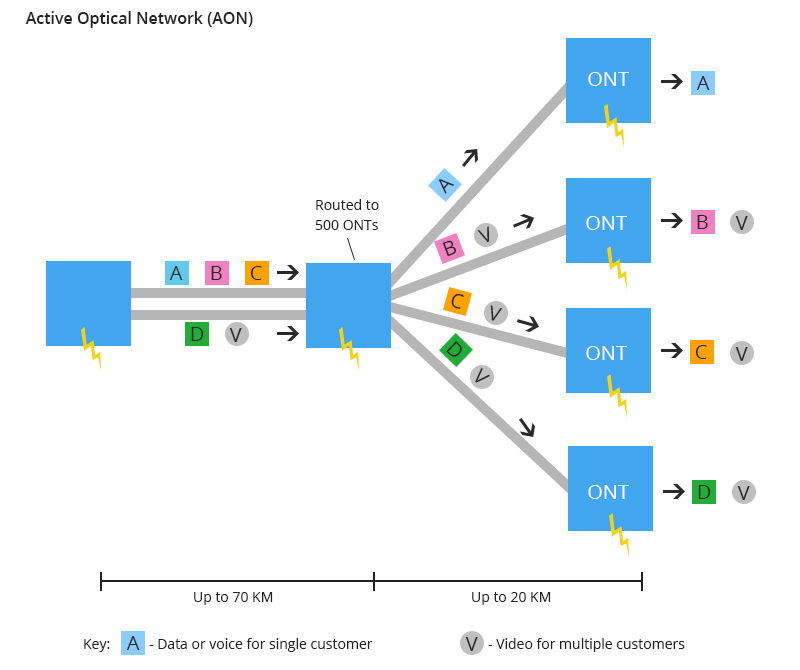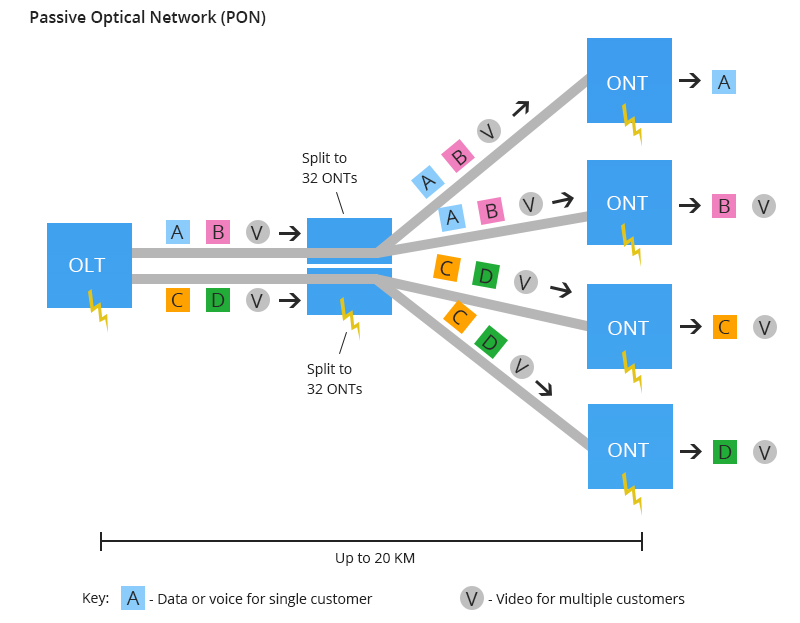AON vs PON Networks: What's the Difference and How to Make Choice?
Fiber to the home (FTTH) is a system which installs optical fiber from a central point directly to individual buildings, including residences and apartments. The deployment of FTTH has significantly progressed, allowing subscribers to adopt optical fibers instead of copper lines for broadband Internet access. There are two basic paths to deploy high-speed FTTH networks: active optical network (AON) and passive optical network (PON). Then AON vs PON networks: what's the difference and how to make the wise choice?
What Is AON Network?
AON (active optical network) is a point-to-point network structure in which each subscriber has its own fiber-optic line that is terminated on an optical concentrator. AON network covers electrically powered switching equipment, such as a router or a switch aggregator, to manage signal distribution and direction signals to specific customers. The switch directs the incoming and outgoing signals to the proper place by opening and closing in various ways. The reliance of the AON network on Ethernet technology makes interoperability among vendors easy. Subscribers can select hardware that delivers an appropriate data transmission rate and scale up as their needs increase without the need to restructure the network. However, the AON network requires at least one switch aggregator for each subscriber.

In an active optical network, three key devices play pivotal roles in facilitating more intricate communication schemes: amplifiers, transponders, and modulators.
Amplifiers
Amplifiers play a crucial role in enhancing the intensity of light traveling through optical fiber cables. They come in two main types: analog and digital. Analog amplifiers, while more cost-effective, are commonly utilized in various settings, including large buildings such as data centers and hospitals. On the other hand, digital amplifiers employ lasers instead of LEDs to generate light, providing advanced capabilities for specific applications.
Transponders
Transponders serve as signal converters, transforming signals from one format to another. For instance, if you intend to transmit a television signal over a phone line, a transponder is essential to convert it into a telephone signal. This conversion enables seamless connectivity, allowing you to directly plug your telephone into the wall jack.
Modulators
Modulators share similarities with transponders but operate in reverse. Instead of converting signals from one format to another, modulators alter the wavelength of an optical signal. This capability is particularly useful when, for example, you need to transmit a red laser beam over a blue fiber. In such a scenario, a modulator comes into play, converting the red laser beam into a blue laser beam to ensure compatibility with the optical medium.
What Is PON Network?
Different from AON networks, PON (passive optical network) is a point to multipoint network structure in which passive optical splitters are used to separate and collect optical signals. The fiber optic splitters allow the PON network to serve multiple subscribers in a single optical fiber without the need to deploy individual fibers between the hub and the end-users. As its name shows, the PON network does not include electrically powered switching equipment and shares fiber optic strands for portions of the network. Powered equipment is required only at the source and receiving ends of the signal.

In a typical PON network, there are several important products and devices that collectively form the PON architecture, providing efficient optical communication and making it a common and effective architecture for delivering broadband access services.
OLT (Optical Line Terminal)
The OLT is the central device in a PON, responsible for sending and receiving optical signals to the user side. It is typically located in the service provider's central office or data center and manages the entire PON network. The FS OLT3610-08GP4S supports Visual WebUI for Real-time Management, allowing users to check important data, alarms, reports, and more through WEB management anytime, whether on-site or remotely. With versatile combinations of PON configurations and stackable deployment options, this lightweight OLT device can be easily adapted for FTTx or POL solutions.
ONU (Optical Network Unit) or ONT (Optical Network Terminal)
The ONT/ONU is the user-side device installed in residences or business premises. It receives optical signals from the OLT and converts them into electrical signals for use by terminal devices. The ONT often functions as a home gateway, providing phone, television, and internet services. FS TA1910-4GVC-W is a home gateway designed specifically for the single-family unit, providing users with high-quality voice, data, high-definition video, and other services. When used in conjunction with an Optical Line Terminal (OLT), it offers an efficient GPON solution for Fiber-to-the-Home (FTTH) and multi-service networks.
PON Transceiver
These PON transceivers are suitable for OLT and ONU devices, facilitating the transmission and reception of optical signals between the OLT and the ONU. By increasing the number of optical modules, network operators can easily expand network capacity and upgrade the PON network.
For more details, please refer to Basic Knowledge About GPON SFP Transceivers.
PLC splitters
The PLC splitters combine multiple optical signals into a single output, or take a single optical input and distribute it to multiple separate outputs. These splitters for PON are bi-directional. To be clear, fiber signals can be sent downstream from the central office, broadcast to all users. And signals from the users can be sent upstream and combined into one fiber to communicate with the central office.
Learn more: What Is an Optical Splitter?
AON vs PON Network: Differences and Selection
Both PON and AON networks make up the fiber backbone in FTTH systems that allow people and businesses access to the internet. Before choosing between a PON or an AON, it's necessary to make clear the differences between them.
AON vs PON Networks: Signal Distribution
When it comes to the AON vs PON network, the main difference between them is the way the optical signal is distributed to each customer in the FTTH system. In an AON system, the subscribers have a dedicated fiber-optic strand, which allows them to get the same bandwidth that isn't shared. While in a PON network, users share the fiber optic strands for a portion of the network in PON. This makes active optical networks more efficient than passive optical networks. Also, it allows AON networks to support greater numbers of users.
AON vs PON Network: Cost
The biggest ongoing expense in a network is the cost of the powering equipment and maintenance. Compared with the AON network that is a powered network, PON makes use of passive components that require less maintenance, and no power is needed. So PON is less expensive than AON.
AON vs PON Networks: Coverage Distance and Applications
AON can cover a distance range of up to 90 km, while PON is usually limited by fiber cable runs of up to 20 km. This means that the PON subscribers must be geographically closer to the originating signal.
In addition, there are some other factors to consider if it is relevant to special applications or services. For example, radiofrequency and video services will be deployed, then a PON is typically the only practical solution. If all services are Internet Protocol-based, however, either a PON or an AON could be appropriate. If there are longer distances involved and providing power and cooling to active components in the field could pose a problem, then a PON may be the best choice. Alternatively, if the target customer is commercial or if the project involves multiple dwelling units, then an AON network may be a better fit.
AON vs PON: Network Expansion
When additional branches are required in the network, the AON network needs to install optical interface boards at tributary nodes to enhance optical directionality. In contrast, the PON network simply requires the replacement of the optical splitter. By utilizing optical splitters with more branches, the optical directionality can be increased. Consequently, PON expansion is significantly more convenient than AON, resulting in lower investment costs.
AON vs PON: Network Security Mechanism
PON comes with a more dependable network security mechanism, encompassing both single-node protection and whole-network protection. Single-node protection ensures that the failure of equipment in one node does not disrupt the operation of other nodes and can withstand simultaneous failures across multiple nodes. Whole-network protection involves employing the same dual optical plane protection mechanism to offer 1+1 channel protection and 1+1 circuit protection, automatically switching the optical plane. This mechanism effectively safeguards the network's security.
AON vs PON Networks: Which Do You Prefer for FTTH?
Overall, both AON and PON represent effective FTTH technologies, each offering distinct advantages tailored to diverse scenarios and applications. When selecting between them, it's crucial to undertake a comprehensive assessment considering factors such as geographical location, application demands, and cost considerations.
AON, despite its relatively higher initial deployment cost, stands out for its ability to deliver a direct and efficient connection. This makes it particularly suited for applications necessitating high bandwidth and low latency, such as healthcare, education, and entertainment sectors. In these fields, where the demand for high-speed internet access is escalating, AON excels in meeting user requirements and ensuring an exceptional experience.
Conversely, PON capitalizes on its point-to-multipoint connectivity and shared bandwidth attributes to provide extensive internet access. Particularly advantageous in urban and densely populated areas, PON efficiently disseminates data to numerous users via a single passive optical splitter, thus markedly reducing fiber demand and associated costs.
Conclusion
The choice between AON and PON depends on your specific requirements and constraints. Both architectures have their advantages and limitations, and the best choice for FTTH will vary based on the unique characteristics of the deployment. FS offers high-quality, customized PON network solutions tailored to your needs. If you have any questions about PON networks or need assistance in selecting the network type, please don't hesitate to get in touch with us.
You might be interested in
Email Address

-
PoE vs PoE+ vs PoE++ Switch: How to Choose?
May 30, 2024













